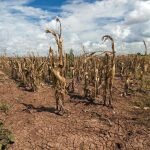If you take a look around the world today, you will find that extreme weather events, such as storms, fires, floods, and droughts, have increased in frequency and intensity.
All of these climate-related disasters bear direct and indirect negative impacts on food security. For the world’s most vulnerable communities already facing hunger and undernourishment, climate change is a severe threat multiplier.
Since 2015, the number of hungry people has been on a steady rise which, according to the Food and Agriculture Organization, is the result of persistent instability in conflict-ridden regions, economic slowdowns in more peaceful regions, and climate shocks.
A 2018 report from FAO showed that undernourishment and severe food insecurity appear to be increasing in almost all regions of Africa. In the context of recent events, undernourishment and acute hunger are indeed on the rise in Africa. Take Angola for instance; the Southern African country is in the throes of severe hunger caused by the worst drought it has seen in 40 years.
Currently, more than 1.3 million people in the three south-western provinces of Cunene, Huila, and Namibe are facing severe hunger as drought leaves fields barren, pasture lands dry and food reserves depleted, according to a recent Integrated Phase Classification (IPC) analysis that categorizes food insecurity.
“Migration of families to other provinces and neighboring Namibia in search of water and grazing for cattle has been registered in the South of the country. These areas have been suffering from the devastating effects of climate change and the current drought puts the food security and nutrition of vulnerable people under threat,” said Michele Mussoni, WFP’s Head of Office in Angola.
High food prices and a locust infestation that has caused severe damage to crops are compounding the effects of the drought, hampering people’s ability to access nutritious food. In the coming months, the situation is likely to worsen with the number of hungry people touching 1.58 million between October and March 2022, the lean season when traditionally food stocks run low.
The drought has also impacted 114,000 children under the age of five who are suffering or likely to suffer from acute malnutrition in the next 12 months, with serious effects on their physical and mental development.
To support the drought response, WFP Angola stated that it has started working with provincial authorities of Huila and Cunene to strengthen the treatment and prevention of acute malnutrition and is working to secure resources for further expansion to other drought-affected areas. To expand nutrition activities to six affected provinces (Benguela, Cunene, Huambo, Huila, Kuanza Sul, Namibe) for the period from October 2021 to May 2022, WFP needs US$ 6.3 million.
WFP’s assistance will be coordinated through the Inter-Ministerial Drought Task Force and will include support on nutrition, vulnerability analysis, and mapping, supply chain, and operations management. WFP will help the Government set up food security and nutrition coordination mechanisms at the provincial level and is discussing other possibilities of support, including food assistance.
WFP highlights the urgent need to support the Government, at the central and provincial levels, and to link emergency response actions with resilience and development interventions, in line with Angola’s National Development Plan.
The IPC analysis was carried out by the Ministry of Agriculture and Fisheries with technical assistance from FAO, UNICEF, and WFP in 17 municipalities of South-Western Angola within the FRESAN program (Strengthening Resilience and Food and Nutrition Security in Angola) funded by the European Union.




![MIT opens Solv[ED] Youth Innovation Challenge for young people ($200,000) Solv[ED] Youth Innovation Challenge - cleanbuild](/wp-content/uploads/2021/09/SolvED-Youth-Innovation-Challenge-150x150.jpg)











![MIT opens Solv[ED] Youth Innovation Challenge for young people ($200,000) Solv[ED] Youth Innovation Challenge - cleanbuild](/wp-content/uploads/2021/09/SolvED-Youth-Innovation-Challenge-74x55.jpg)



